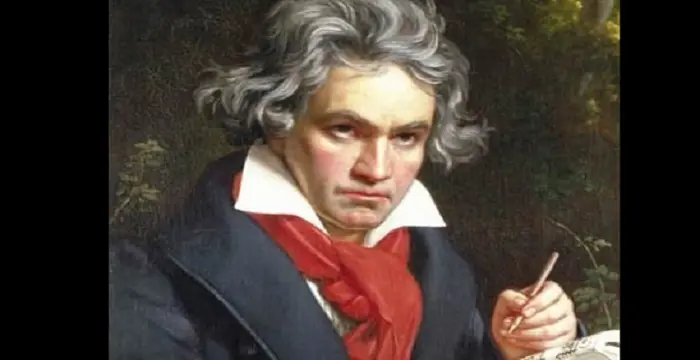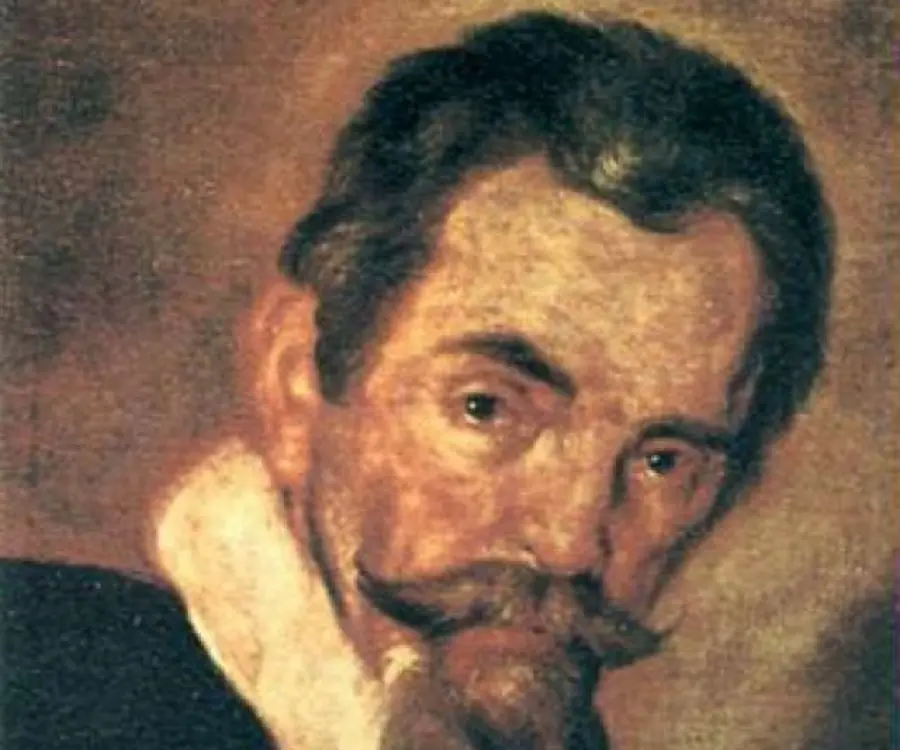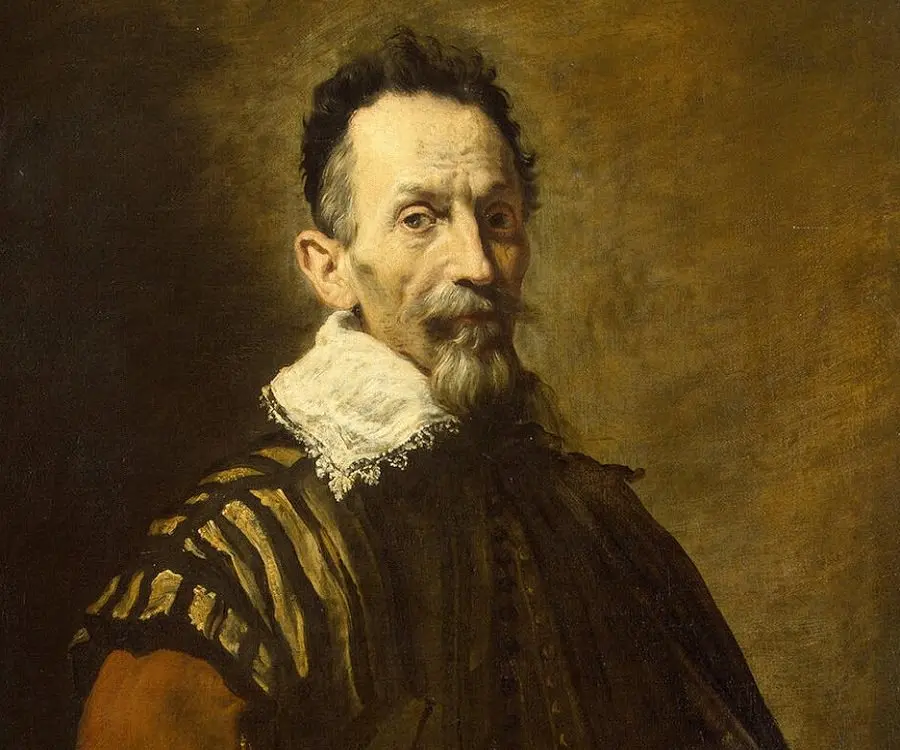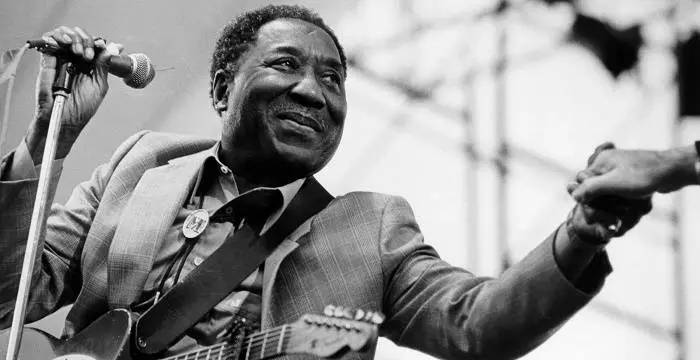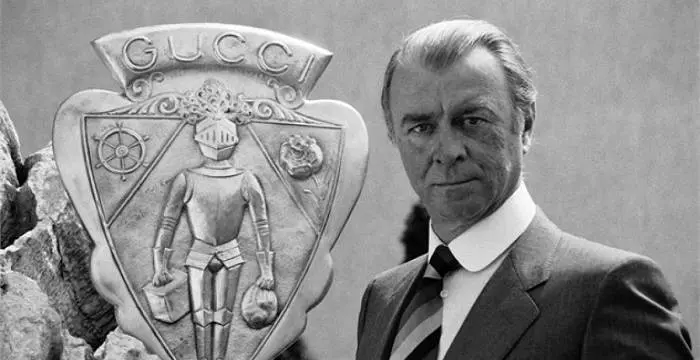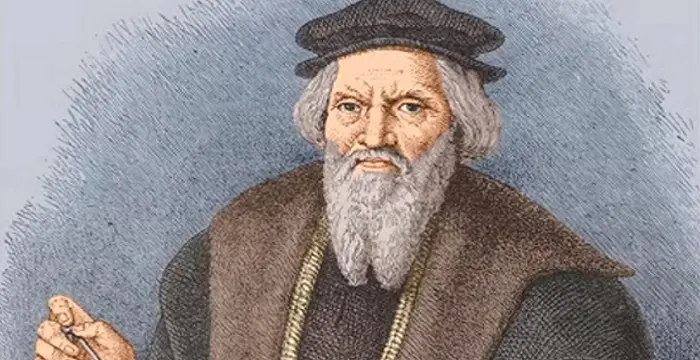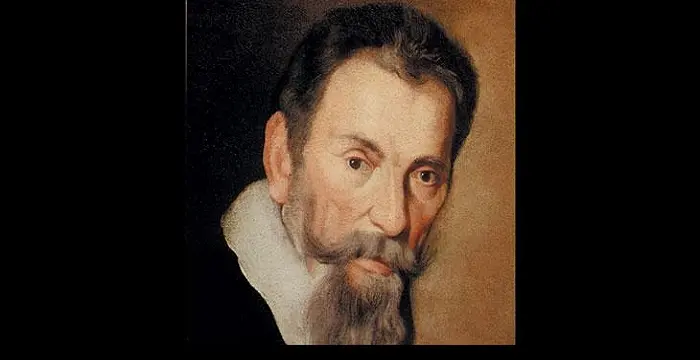
Claudio Monteverdi - Musicians, Timeline and Childhood
Claudio Monteverdi's Personal Details
Claudio Monteverdi was an Italian Renaissance composer and a significant developer of new genre — ‘operas’
| Information | Detail |
|---|---|
| Birthday | May 15, 1567 |
| Died on | November 29, 1643 |
| Nationality | Italian |
| Famous | Musicians, Composers |
| Spouses | Claudia Cattaneo |
| Childrens | Francesco, Leonora, Massimilino |
| Universities |
|
| Birth Place | Cremona |
| Religion | Roman Catholic |
| Gender | Male |
| Sun Sign | Taurus |
| Born in | Cremona |
| Famous as | Composer |
| Died at Age | 76 |
// Famous Composers
Ludwig van Beethoven
Ludwig Van Beethoven was one of the greatest composers the world has ever had. Check out this biography to know about his childhood, family life, and achievements.
Emina Jahović
Emina Jahović Sandal is a Serbian model, actress and singer-songwriter. Know more about her childhood, life, career, achievements and timeline in this biography.
John Denver
John Denver, a famous American singer-songwriter and activist, is remembered for songs like Take Me Home, Country Roads and Annie's Song. To know more about his childhood, career, profile and timeline read on
Claudio Monteverdi's photo
Who is Claudio Monteverdi?
Claudio Monteverdi was an Italian Renaissance composer and a significant developer of new genre — ‘operas’. Working extensively in the tradition of early Renaissance polyphony and concurrently employing the basso continuo technique, an important feature of the Baroque period, he also became a bridge between these two distinctive eras of music history. Born in the middle of the sixteenth century in the Lombardy region of Italy, he studied music with Marc’Antonio Ingegneri, the maestro at the local cathedral. He started writing both religious and secular music early in his life, publishing his first work at the age of 15. Around the age of 22, he started his career as a string player at the Court of Mantua, being appointed to the position of the maestro di capella at the age of 35. Later, he moved to Venice, where he was appointed to the same post at the St. Mark’s. Remaining there till his death, he wrote much religious as well as secular music, also introducing secular elements into church music. 'La favola d'Orfeo', one of his first operas, is being regularly performed till now.
// Famous Musicians
Ted Nugent
Ted Nugent is a hard rock musician known for his hits ‘Stranglehold’ and ‘Cat Scratch Fever’. This biography of Ted Nugent provides detailed information about his childhood, life, achievements, works & timeline.
Muddy Waters
Muddy Waters was a blues musician referred to as the 'father of modern Chicago blues.' Check out this biography to know about his childhood, family life, achievements and fun facts about him.
Travis Bacon
Travis Bacon is an American musician and actor, better known as the son of veteran actors Kevin Bacon and Kyra Sedgwick. Find more about his family, birthday, etc.
Childhood & Early Life
Claudio Giovanni Antonio Monteverdi was born in 1567 in Cremona, Lombardy, Italy. Although his exact date of his birth is not known, the records at the church of SS Nazaro e Celso, Cremona states that he was baptized on 15 May 1567 as Claudio Zuan Antonio.
At the time of his birth, Cremona was under the administration of Milan. But because Milan was assigned to Spain under the 1513 Treaty of Noyon he was technically born a Spanish citizen. However, he always considered himself an Italian.
His father, Baldassare Monteverdi, was a barber surgeon and an apothecary while his mother, Maddalena Monteverdi née Zignani, was the daughter of a goldsmith. Claudio was the eldest of his parents’ six children, having three brothers and two sisters. His next brother, Giulio Cesare, also became a renowned musician.
Claudio lost his mother when he was eight or nine years old. By then, Baldassare Monteverdi had made a modest move up the social ladder. In 1576 or 1577, he took a second wife, Giovanna Gadio, fathering three more children with her. But she too died early.
His father next married Francesca Como; but this marriage was childless. In spite of having to adjust to two step mothers, Claudio remained emotionally close to his father, feeling empathy for his father’s repeated losses. It would one day have effect on many of his compositions.
Apart from being an efficient apothecary, his father must have also been musical. At least, he was capable of appreciating the musical talent of his two eldest sons, both of whom began their training in music as choir boys at the local cathedral. However, there is no record about this.
At some point of his boyhood, Claudio began to study music with Marc’Antonio Ingegneri, at that time the maestro di cappella of the Cremona Cathedral. However, there is no proof of this except Claudio’s own admission in his early publications.
Ingegneri was a composer of international repute and a master of the musica reservata vocal style. Under his tutelage, Claudio not only learned to sing, but also developed mastery over violin and other instruments belonging to viol family.
Ingegneri also grounded in his pupil the techniques of Renaissance polyphonic writing. Claudio Monteverdi’s first opus, published in 1582 from Vienna, provided clear indication of this. Entitled ‘Sacrae cantiunculae’, it was followed by ‘Madrigali spirituali’, printed in 1583 from Brescia. In both these publications, he claimed to be Ingegneri’s student.
At Mantua
Claudio Monteverdi began his career in music early in his life. At the time of publication of ‘Sacrae cantiunculae’, he was barely 15 years old. Thereafter, he continued writing and by the time he was 20, he had number of works, both religious and secular, in print.
In 1587, in order to secure the patronage of Marco Verita, the Count of Verona, Monteverdi dedicated his ‘First Book of Madrigals’ to him; but it failed to achieve its objective. In the same year, he played ‘viola da braccio’ for Giacomo Ricardi, the President of the Senate of Milan.
In 1589, he left Cremona to become a string player in the Court of Duke Vincenzo I Gonzaga of Mantua. At that time, the Duke was trying to establish his court as a center for music, appointing noted musicians from across Europe as his court musicians.
It was an ideal place to learn and young Monteverdi greatly benefitted from such association, observing and later participating in the theatrical activities in the court. He was especially influenced by the Flemish musician Giaches de Wert, the maestro di capella at the court.
In 1590, he had his ‘Second Book of Madrigals’ published from Venice. He dedicated the work to Giacomo Ricardi of Milan, perhaps indicating he was still looking for permanent position. But soon after that, the situation became more stable.
By early 1590s, Monteverdi was able to establish his position at Mantua. When in 1592, he had ‘Third Book of Madrigals’ published, he dedicated the work to the Duke Vincenzo I Gonzaga. Thereafter for the next eleven years, he published very little. However, he continued to compose.
One reason for the lull in his publication could be that he was embittered to be passed over for the post of Maestro di capella in 1596. But there was no doubt that the Duke held him in high esteem; asking Monteverdi to accompany him on his visits abroad.
In 1595, Monteverdi accompanied the Duke on his military campaigns to Hungary. Once again in 1599, he was a part of the Duke’s entourage to Flanders, where he became acquainted with the French school of contemporary music. Later in 1600, he possibly accompanied the Duke on his trip to Florence.
Maestro di capella
In 1601, Benedetto Pallavicino, who had succeeded Giaches de Wert in 1596 as the maestro di capella, thus embittering Monteverdi, died. In 1602, 35 year old Monteverdi was appointed in his place. On finally achieving his goal, he once more started publishing his works
In 1603 and 1605, he published two more madrigals, both of which contained masterpieces. Although he still followed the meaning of the verse he often used intense and prolonged dissonance, which invited criticism from the more conservative musicians, chiefly Giovanni Maria Artusi, who attacked him in a series of pamphlets.
Although initially Monteverdi was reluctant to reply he later made an important statement on the nature of his work. In it, he said that he was merely following a tradition that had been developing over a period of fifty years, which sought to create a union between words and music.
The debate had a positive effect on his popularity, establishing him as a composer even outside northern Italy. Very soon, he became famous for his exquisite miniature works.
In 1606, Francesco, who would succeed Duke Vincenzo in 1612, commissioned him to write an opera to a libretto by Alessandro Striggio, for the Carnival season of 1607. Entitled, 'La favola d'Orfeo', the opera was performed in February and March 1607, establishing him as a composer of large-scale music.
Also in 1607, he wrote his second opera, ‘L'Arianna’, to a libretto of Ottavio Rinuccini for Francesco’s wedding to Margherita of Savoy, to be held in 1608. Concurrently, he wrote a ballet, 'Il ballo delle ingrate' and composed the music for an intermezzo to a play.
The hard work affected his health and in 1608, he returned to Cremona, asking for an honorable dismissal. Increasingly poor remunerations were another reason for it. When his request was turned down and his remuneration was raised, he unwillingly returned to Mantua.
Once in Mantua, he started looking for alternative position; but unhappy that he was, he did not remain unproductive. However, his works during this period reflected his deep depression. Among his works during this period, most significant was ‘Vesperis in Festis Beata Mariae Vergine’ (1610)
In Venice
After the death of Duke Vincenzo on 18 February 1612, Monteverdi was dismissed by his successor Duke Francesco, partly because of court intrigues and partly because of cost-cutting. Thereafter, he returned to Cremona, almost penniless, looking for alternative position. His brother, also a musician at the court, returned with him.
When in 1613, Giulio Cesare Martineng, the maestro at San Marco in Venice, passed away, Claudio Monteverdi auditioned for his post, submitting music for a Mass. He received appointment as maestro di capella at San Marco in August 1613 and immediately moved to Venice.
Although Monteverdi was not a church musician, he took up his duties seriously, completely revitalizing music at the basilica, which had been declining since 1609. He held regular choral services and hired best musicians. Among them were would-be famous composers like Francesco Cavalli and Alessandro Grandi.
He also wrote a lot of church music, which included among other pieces, two Masses, two Magnificats, a litany, dozens of psalm settings. In 1640, he published some of them in ‘Selva morale e spirituale’ while the rest were published posthumously in 1650. Concurrently, he also continued to write secular music.
Claudio Monteverdi published his ‘Sixth Book of Madrigals’ in 1614. It would be followed by two more books on Madrigals, to be published in 1619 and 1638 respectively. Meanwhile, he also renewed his contact with the Court at Mantua, writing a ballet ‘Tirsi e Clori’, for Ferdinand of Mantua in 1616.
He also tried to write a few operas for the Court at Mantua, abandoning them in the midway. Instead, he concentrated on creating a practical philosophy of music, which found expression in his 1624 dramatic cantata, ‘Il combattimento di Tancredi e Clorinda’ and 1627 comic opera, whose score is now lost.
Taking Holy Order
In 1630, plague broke out in Venice, leaving Monteverdi without commission. Sometime now, he decided to take the Holy Order, being admitted to the tonsure in 1631. In November, as the epidemic was declared over, he wrote a grand mass for the thanksgiving service at San Marco.
In 1632, he was ordained a deacon. In the same year, he published his second set of Scherzi musicali, the first set being published in 1607, when he was maestro at Mantua.
Continuing to write both religious and secular music, he published a ballet entitled ‘Volgendo il ciel’ in 1637 and ‘Eighth Book of Madrigals’ in 1638. He was then 70 year old and his musical career was thought to be over by now. But it did not.
Opera Writer
In 1637, Venice saw the opening of his first opera. Already experienced in production of operas, it is natural that Monteverdi would be involved with from the very beginning. ‘L’Arianna’, written in 1607, was revived and performed.
Throughout his life, he is believed to have written 18 operas and at least four of them in early 1640s. However, among the four, only two survive to this day.
'Il ritorno d'Ulisse in patria’, one of the surviving operas, was written for the carnival season of 1639-1640. Taken from the second half of Homer's Odyssey, the libretto was written by Giacomo Badoaro. Today, it is considered as one of the first modern operas.
The other surviving opera, entitled ‘L'incoronazione di Poppea’, was written for 1643 carnival. Written to the libretto by Giovanni Francesco Busenello, it was one of the first operas to use historical events, describing how Emperor Nero’s mistress, Poppaea, became the crowned princess.
Major Works
Today, Claudio Monteverdi is remembered as one of the important developers of opera music. 'La favola d'Orfeo', first performed in 1607, is probably his most popular work in this genre. It is also one of the earliest surviving operas, which is still being regularly performed.
Personal Life & Legacy
In 1599, Monteverdi married Claudia de Cattaneo, a singer at the Court of Duke Vincenzo I Gonzaga of Mantua. They had three children; two sons named Francesco and Massimiliano and a daughter, Leonora, who died soon after her birth. Claudia also died in September 1607, leaving him devastated.
Claudia Monteverdi died on 29 November 1643, at the age of 76, in Venice. He was buried at Santa Maria Gloriosa dei Frari, also in Venice.
His unpublished religious works were posthumously published in 1650. In the following year, unpublished lighter pieces such as canzonettas, which he seemed to have written throughout his life, were published as ‘Ninth Book of Madrigals’.
// Famous Italian peoples
Pietro Boselli
Pietro Boselli is an Italian model, engineer, teacher, and fitness athlete who became famous as the ‘world’s sexiest math teacher’. Check out this biography to know about his birthday, childhood, family life, achievements and fun facts about him.
Guccio Gucci
Guccio Gucci was a famous fashion designer from Florence, Italy, and the founder of the world-renowned fashion brand ‘Gucci.’ Check out this biography to know about his childhood, family, personal life, career, etc.
John Cabot
John Cabot was an Italian navigator and explorer who was the first European to discover the coast of North America. Check out this biography to know about his childhood, life, and achievements.
Claudio Monteverdi biography timelines
- // 1567Claudio Giovanni Antonio Monteverdi was born in 1567 in Cremona, Lombardy, Italy. Although his exact date of his birth is not known, the records at the church of SS Nazaro e Celso, Cremona states that he was baptized on 15 May 1567 as Claudio Zuan Antonio.
- // 1576Claudio lost his mother when he was eight or nine years old. By then, Baldassare Monteverdi had made a modest move up the social ladder. In 1576 or 1577, he took a second wife, Giovanna Gadio, fathering three more children with her. But she too died early.
- // 1583Ingegneri also grounded in his pupil the techniques of Renaissance polyphonic writing. Claudio Monteverdi’s first opus, published in 1582 from Vienna, provided clear indication of this. Entitled ‘Sacrae cantiunculae’, it was followed by ‘Madrigali spirituali’, printed in 1583 from Brescia. In both these publications, he claimed to be Ingegneri’s student.
- // 1587In 1587, in order to secure the patronage of Marco Verita, the Count of Verona, Monteverdi dedicated his ‘First Book of Madrigals’ to him; but it failed to achieve its objective. In the same year, he played ‘viola da braccio’ for Giacomo Ricardi, the President of the Senate of Milan.
- // 1589In 1589, he left Cremona to become a string player in the Court of Duke Vincenzo I Gonzaga of Mantua. At that time, the Duke was trying to establish his court as a center for music, appointing noted musicians from across Europe as his court musicians.
- // 1590In 1590, he had his ‘Second Book of Madrigals’ published from Venice. He dedicated the work to Giacomo Ricardi of Milan, perhaps indicating he was still looking for permanent position. But soon after that, the situation became more stable.
- // 1592By early 1590s, Monteverdi was able to establish his position at Mantua. When in 1592, he had ‘Third Book of Madrigals’ published, he dedicated the work to the Duke Vincenzo I Gonzaga. Thereafter for the next eleven years, he published very little. However, he continued to compose.
- // 1595In 1595, Monteverdi accompanied the Duke on his military campaigns to Hungary. Once again in 1599, he was a part of the Duke’s entourage to Flanders, where he became acquainted with the French school of contemporary music. Later in 1600, he possibly accompanied the Duke on his trip to Florence.
- // 1596One reason for the lull in his publication could be that he was embittered to be passed over for the post of Maestro di capella in 1596. But there was no doubt that the Duke held him in high esteem; asking Monteverdi to accompany him on his visits abroad.
- // 1596In 1601, Benedetto Pallavicino, who had succeeded Giaches de Wert in 1596 as the maestro di capella, thus embittering Monteverdi, died. In 1602, 35 year old Monteverdi was appointed in his place. On finally achieving his goal, he once more started publishing his works
- // 1599In 1599, Monteverdi married Claudia de Cattaneo, a singer at the Court of Duke Vincenzo I Gonzaga of Mantua. They had three children; two sons named Francesco and Massimiliano and a daughter, Leonora, who died soon after her birth. Claudia also died in September 1607, leaving him devastated.
- // 1603In 1603 and 1605, he published two more madrigals, both of which contained masterpieces. Although he still followed the meaning of the verse he often used intense and prolonged dissonance, which invited criticism from the more conservative musicians, chiefly Giovanni Maria Artusi, who attacked him in a series of pamphlets.
- // 1606In 1606, Francesco, who would succeed Duke Vincenzo in 1612, commissioned him to write an opera to a libretto by Alessandro Striggio, for the Carnival season of 1607. Entitled, 'La favola d'Orfeo', the opera was performed in February and March 1607, establishing him as a composer of large-scale music.
- // 1607Also in 1607, he wrote his second opera, ‘L'Arianna’, to a libretto of Ottavio Rinuccini for Francesco’s wedding to Margherita of Savoy, to be held in 1608. Concurrently, he wrote a ballet, 'Il ballo delle ingrate' and composed the music for an intermezzo to a play.
- // 1607In 1632, he was ordained a deacon. In the same year, he published his second set of Scherzi musicali, the first set being published in 1607, when he was maestro at Mantua.
- // 1607Today, Claudio Monteverdi is remembered as one of the important developers of opera music. 'La favola d'Orfeo', first performed in 1607, is probably his most popular work in this genre. It is also one of the earliest surviving operas, which is still being regularly performed.
- // 1608The hard work affected his health and in 1608, he returned to Cremona, asking for an honorable dismissal. Increasingly poor remunerations were another reason for it. When his request was turned down and his remuneration was raised, he unwillingly returned to Mantua.
- // 1609Although Monteverdi was not a church musician, he took up his duties seriously, completely revitalizing music at the basilica, which had been declining since 1609. He held regular choral services and hired best musicians. Among them were would-be famous composers like Francesco Cavalli and Alessandro Grandi.
- // 1610Once in Mantua, he started looking for alternative position; but unhappy that he was, he did not remain unproductive. However, his works during this period reflected his deep depression. Among his works during this period, most significant was ‘Vesperis in Festis Beata Mariae Vergine’ (1610)
- // 1612After the death of Duke Vincenzo on 18 February 1612, Monteverdi was dismissed by his successor Duke Francesco, partly because of court intrigues and partly because of cost-cutting. Thereafter, he returned to Cremona, almost penniless, looking for alternative position. His brother, also a musician at the court, returned with him.
- // 1613When in 1613, Giulio Cesare Martineng, the maestro at San Marco in Venice, passed away, Claudio Monteverdi auditioned for his post, submitting music for a Mass. He received appointment as maestro di capella at San Marco in August 1613 and immediately moved to Venice.
- // 1614Claudio Monteverdi published his ‘Sixth Book of Madrigals’ in 1614. It would be followed by two more books on Madrigals, to be published in 1619 and 1638 respectively. Meanwhile, he also renewed his contact with the Court at Mantua, writing a ballet ‘Tirsi e Clori’, for Ferdinand of Mantua in 1616.
- // 1624He also tried to write a few operas for the Court at Mantua, abandoning them in the midway. Instead, he concentrated on creating a practical philosophy of music, which found expression in his 1624 dramatic cantata, ‘Il combattimento di Tancredi e Clorinda’ and 1627 comic opera, whose score is now lost.
- // 1630In 1630, plague broke out in Venice, leaving Monteverdi without commission. Sometime now, he decided to take the Holy Order, being admitted to the tonsure in 1631. In November, as the epidemic was declared over, he wrote a grand mass for the thanksgiving service at San Marco.
- // 1637Continuing to write both religious and secular music, he published a ballet entitled ‘Volgendo il ciel’ in 1637 and ‘Eighth Book of Madrigals’ in 1638. He was then 70 year old and his musical career was thought to be over by now. But it did not.
- // 1637In 1637, Venice saw the opening of his first opera. Already experienced in production of operas, it is natural that Monteverdi would be involved with from the very beginning. ‘L’Arianna’, written in 1607, was revived and performed.
- // 1640He also wrote a lot of church music, which included among other pieces, two Masses, two Magnificats, a litany, dozens of psalm settings. In 1640, he published some of them in ‘Selva morale e spirituale’ while the rest were published posthumously in 1650. Concurrently, he also continued to write secular music.
- // 1643The other surviving opera, entitled ‘L'incoronazione di Poppea’, was written for 1643 carnival. Written to the libretto by Giovanni Francesco Busenello, it was one of the first operas to use historical events, describing how Emperor Nero’s mistress, Poppaea, became the crowned princess.
- // 29th Nov 1643Claudia Monteverdi died on 29 November 1643, at the age of 76, in Venice. He was buried at Santa Maria Gloriosa dei Frari, also in Venice.
// Famous Taurus Celebrities peoples
Jason Simpson
Jason Simpson is the son of former NFL running back, broadcaster and actor O. J. Simpson. Check out this biography to know about his childhood, family, life, and little known facts about him.
Sophie Reade
Sophie Victoria Reade is a British model and reality show star. Let’s take a look at her family and personal life, including her age, birthday, boyfriends, and some interesting facts.
ASMR Aspen
ASMR Aspen is an American YouTuber. Check out this biography to know about her birthday, childhood, family life, achievements and fun facts about her.
Bertil Gotthard Ohlin
Bertil Gotthard Ohlin was a famous Swedish economist. This biography profiles his childhood, family life & achievements.
Josh Temple
Check out all that you wanted to know about Josh Temple (Slogoman), the famous British YouTube Personality; his birthday, his family and personal life, his girlfriends, fun trivia facts and more.
Aidan Prince
Aidan Prince is an American dancer, actor and vlogger. Let’s have a look at his family and personal life including age, date of birth, net worth, and fun facts.
Claudio Monteverdi's FAQ
What is Claudio Monteverdi birthday?
Claudio Monteverdi was born at 1567-05-15
When was Claudio Monteverdi died?
Claudio Monteverdi was died at 1643-11-29
Where was Claudio Monteverdi died?
Claudio Monteverdi was died in Venice
Which age was Claudio Monteverdi died?
Claudio Monteverdi was died at age 76
Where is Claudio Monteverdi's birth place?
Claudio Monteverdi was born in Cremona
What is Claudio Monteverdi nationalities?
Claudio Monteverdi's nationalities is Italian
Who is Claudio Monteverdi spouses?
Claudio Monteverdi's spouses is Claudia Cattaneo
Who is Claudio Monteverdi childrens?
Claudio Monteverdi's childrens is Francesco, Leonora, Massimilino
What was Claudio Monteverdi universities?
Claudio Monteverdi studied at University of Cremona
What is Claudio Monteverdi's religion?
Claudio Monteverdi's religion is Roman Catholic
What is Claudio Monteverdi's sun sign?
Claudio Monteverdi is Taurus
How famous is Claudio Monteverdi?
Claudio Monteverdi is famouse as Composer
